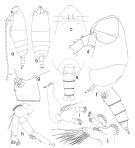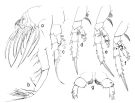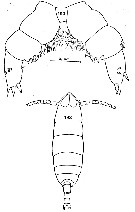|
|
 |
|
Calanoida ( Order ) |
|
|
|
Clausocalanoidea ( Superfamily ) |
|
|
|
Phaennidae ( Family ) |
|
|
|
Cephalophanes ( Genus ) |
|
|
| |
Cephalophanes frigidus Wolfenden, 1911 (F,M) | |
| | | | | | | Syn.: | ? no Cephalophanes frigidus : Tanaka, 1960 a (p.124, figs.F, juv.F) | | | | Ref.: | | | Wolfenden, 1911 (p.284, Descr.F, figs.F); Steuer, 1926 (p.183, figs.F,M); Farran, 1929 (p.209, 254, fig.F, Rem.); Vervoort, 1957 (p.93, Rem.); Owre & Foyo, 1967 (p.58, figs.F,M); Séret, 1979 (p.110, fig.F); Park, 1983 a (p.321, figs.F, Rem.F); Chihara & Murano, 1997 (p.852, Pl.139: F); Vives & Shmeleva, 2007 (p.681, figs.F, Rem.); Park & Ferrari, 2009 (p.143, Table 3, Appendix 1, biogeography from Southern Ocean) |  issued from : G.P. Farran in British Antarctic (\"Terra Nova\") Expedition, 1910. Natural History Reports. Zoology. Vol. VIII. Crustacea., 1929. [p.254, Fig.20] Female: fifth feet.
|
 issued from : T. Park in Antarct. Res. Ser. Washington, 1983, 39 (5). [p323, Fig.3]. Female: a, habitus (lateral left side); b, idem (dorsal); c, forehead (ventral); d, idem (lateral); e, last thoracic segment and urosome (dorsal); f, posterior part of metasome with P5 and urosome (lateral left side); g, genital segment (lateral left side); h, A2; i, Md; j, Mx1.
|
 issued from : T. Park in Antarct. Res. Ser. Washington, 1983, 39 (5). [p324, Fig.4]. Female: a, Mx2; b, Mxp; c, P1 (anterior); d, P2 (posterior); e, P3 (posterior); f, P4 (posterior); g, P5 (posterior).
|
 issued from : R.N. Wolfenden in Die Marinen Copepoden der Deutschen Südpolar-Expedition 1901-1903, 1911. [p.284, Fig.46]. Female (from Antarctic continent): a, habitus (lateral); b, Mx2; c, P5.
|
 issued from : A. Steuer in Wiss. Ergebn. dt. Tiefsee-Exped. \"Valdivia\", 1926, 23. [p.184, Figs.8-14]. Female: 8, habitus (dorsal); 9, posterior part of thorax and urosome (lateral); 10, forehead (ventral); 11, P1; 12, P2; 13, P3; 14, P5.
|
 issued from : A. Steuer in Wiss. Ergebn. dt. Tiefsee-Exped. \"Valdivia\", 1926, 23. [p.185, Figs.15-17]. Male: 15, habitus (dorsal); 16, posterior part of thorax with P5 and urosome (lateral); 17, P5. L = left leg; R = right leg.
|
 Issued from : C. Séret in Thesis 3ème Cycle, UPMC, Paris 6. [Pl. XXXII, Figs.192, 193]. Female (from off Kerguelen Is.): 192, habitus (dorsal); 193, P5. Nota: The Kerguelen Islands' specimen differs from Steuer's description (1926) by only 2 or 3 spines close on surface of last segment of P5, whereas we note 2 rows of 3 to 4 srrong spines in the Steuer's specimen. More, female P5 ends by 3 teeth against 2 in Steuer, the inner is slightly shorter than the outer.
| | | | | Compl. Ref.: | | | Hardy & Gunther, 1935 (1936) (p.163, Rem.); Vinogradov, 1968 (1970) (p.166); Bainbridge, 1972 (p.61, Appendix Table III: occurrence); Harding, 1974 (p.141, tab.2, gut contents); Deevey & Brooks, 1977 (p.256, Table 2, station "S"); Björnberg, 1973 (p.331, 385); Vives, 1982 (p.292); Hopkins, 1985 (p.197, Table 1, gut contents); Hopkins & Torres, 1988 (tab.1); Voronina & Kolosova, 1999 (p.71); Razouls & al., 2000 (p.343, tab.5, Appendix); Schnack-Schiel & al., 2008 (p.1045: Tab.2); Homma & Yamaguchi, 2010 (p.965, Table 2); Medellin-Mora & Navas S., 2010 (p.265, Tab. 2); Homma & al., 2011 (p.29, Table 2, 3, abundance, feeding pattern: suspension feeders); | | | | NZ: | 11 | | |
|
Distribution map of Cephalophanes frigidus by geographical zones
|
| | | | | | | | |  Chart of 1996 Chart of 1996 | |
 issued from : W. Vervoort in B.A.N.Z. Antarctic Reseach Expedition, Reports - Ser. B, Vol. III, 1957 [Fig.124] issued from : W. Vervoort in B.A.N.Z. Antarctic Reseach Expedition, Reports - Ser. B, Vol. III, 1957 [Fig.124]
Chart showing the geographical distribution (white circle) in the seas surrounding the Antarctic continent.
Nota: In this chart the area frequented by whaling vessels has been hatched. The Antarctic circle (66°.5 S) has been drawn as a broken line. The numbers I to VI refer to the sectors into which the Antarctic seas are divided according to Mackintosh (1942) (after Vervoort, 1951). |
 issued from : A. Steuer in Wiss. Ergebn. dt. Tiefsee-Exped. \"Valdivia\", 1926, 23. [p.186, Fig.18]. issued from : A. Steuer in Wiss. Ergebn. dt. Tiefsee-Exped. \"Valdivia\", 1926, 23. [p.186, Fig.18].
Geograpphic distribution of cephalophanes frigidus (white circle, male and female indicated) and C. refulgens (black circle; male and female indicated). |
 Issued from : C. Séret in Thesis 3ème Cycle, UPMC, Paris 6. 1979, Annexe. [p.36]. Issued from : C. Séret in Thesis 3ème Cycle, UPMC, Paris 6. 1979, Annexe. [p.36].
Geographical occurrences of Cephalophanes frigidus in the Indian Ocean and Antarctic zone. [after publications from: Brady, 1883, 1918; Thompson, 1900; Wolfenden, 1908, 1911; With , 1915; Rosendorn, 1917; Farran, 1929; Sewell, 1929, 1947; Brady & Gunther, 1935; Steuer, 1929, 1392, 1933; Ommaney, 1936; Vervoort, 1957; Tanaka, 1960; Brodsky, 1964; Seno, 1966; Andrews, 1966; Grice & Hulsemann, 1967; Seno, 1966; Frost & Fleminger, 1968; Voronina, 1970; Zverva, 1972].
C. Séret notes the occurrence at station 56°S, 70°E. |
| | | | Loc: | | | Antarct. (Croker Passage, Peninsula, SW Atlant., Weddell Sea, Indian, SW & S Pacif.), South Georgia, sub-Antarct. (Indian, SW & SE Pacif.), SE Atlant. Atlant. (tropical), G. of Guinea, off Lagos, off Mauritania, Caribbean Colombia, Caribbean Sea, Florida, off Bermuda: Station "S" (32°10'N, 64°30'W), off E Cape Cod, Arabian Sea, Indian, Arafura Sea, Japan (Izu region), S Peru S, Bering Sea, S Aleutian Basin), S Aleutian Is. | | | | N: | 21 | | | | Lg.: | | | (10) F: 5; (15) F: 4,72-4,2; (25) F: 5; (35) F: 4,32; (42) F: 5,05-4; M: 4,05-3,7; (246) F: 4,1; (866) M: 3-4; {F: 4,00-5,05; M: 3,70-4,05} | | | | Rem.: | bathypelagic.
Sampling depth (Antarct., sub-Antarct.) : 500-2000 m. Sargasso Sea: 500-2000 m (Deevey & Brooks, 1977, station "S"); 2000-1000 m (Harding, 1974).
For Vervoort (1957, p.93) the differences between C. frigidus and C. refulgens females are not as large as would appear from a comparison between Wolfenden's and Sars' descriptions (cf. Steuer, 195, p.185); the differences between the females are mainly based on the structure of P5. Farran (1929) described a female, provisionally brought to C. frigidus, which is intermediate in the structure of P5, so that Farran would even be inclined to unite both forms, were it not that Steuer (l.c) has described two different types of males, attributed to the two species. Farran recorded the intermediate specimen from an area where previously only C. frigidus has been captured. As the number of females, especially of C. frigidusrecorded up to the present time, is very restricted and an intermediate form has only once been found, it seems advisable to leave both species separated. The specimens from Antarctic (Indian sector) and southern Indain Ocean are recorded by Vervoort (1957) as C. frigidus; the young female from Antarctic Indian sector almost certainly belongs to the same species; C. refulgens has never been captured, up to 1957, in the Antarctic. It seems to have escaped the attention of Steuer and Farran (1929) that the males described by the former are not adult but represent a copepodid stage (probably C5).
According to Tanaka (1960, p.126) the specimen reported by Wolfenden or Steuer has no inner marginal spine on the 3rd segment of P5. Farran's specimen from the Antarctic has an inner marginal spine, considerd to be intermediate form between C. refulgens and C. frigidus, taken from the area 66°S and 30°-76°S.
After Park (1983 a, p.324) the Tanaka's specimen female from Sagami Bay (Japan) seems rather closer to C. refulgens than C. frigidus because the relative sizes of the spines on the 3rd segment of P5. Tanaka & Omori (1992, p.254) follow the Pärk's observation. Owre & Foyo (1964) recorded the species from the Caribbean Sea, but without adequate descriptions or figures, their record cannot be verified. | | | Last update : 20/02/2017 | |
|
|
 Any use of this site for a publication will be mentioned with the following reference : Any use of this site for a publication will be mentioned with the following reference :
Razouls C., Desreumaux N., Kouwenberg J. and de Bovée F., 2005-2025. - Biodiversity of Marine Planktonic Copepods (morphology, geographical distribution and biological data). Sorbonne University, CNRS. Available at http://copepodes.obs-banyuls.fr/en [Accessed October 14, 2025] © copyright 2005-2025 Sorbonne University, CNRS
|
|
 |
 |












